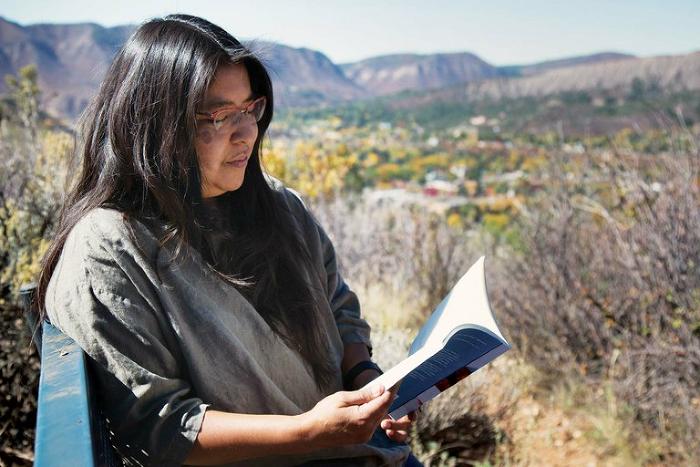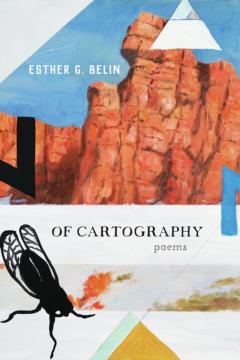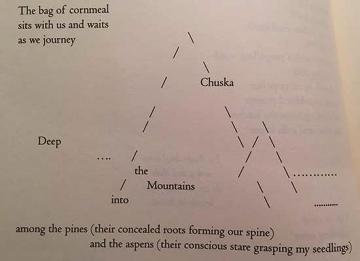 |
Canku Ota
|
 |
|
(Many Paths)
|
||
|
An Online Newsletter
Celebrating Native America
|
||
|
December 2017 - Volume
15 Number 12
|
||
|
|
||
|
A Map Of Language
Charted By Navajo Philosophy
|
||
|
by Heather Hansman -
High Country News
|
||
|
Esther Belin is trying to shape a uniquely Navajo way of writing. Outside her office at the Peaceful Spirit Treatment Center on the Southern Ute Reservation, Navajo poet Esther Belin takes in the thin late-fall sun. Here in the Four Corners of southwestern Colorado, where the Southern Ute, Navajo, Ute Mountain Ute and Jicarilla Apache reservations come together, the landscape is both beautiful and brutal in its spareness, much like Belin's poems. She's also an intake counselor at the addiction center, and she lives and works in that world of intersectionality, where language and identity overlap with the triumphs and failures of addiction.
That bundling of ideas draws on Diné language and culture. "The written tradition for us started in boarding school," she says. "Tribal language is not compartmentalized; it's about how you're connected to all these things. Tribal people have a history of trauma from learning that communication form, of reformulating to fit the structure." Because of that, she says, she started Of Cartography with form instead of content. She sought to reflect the fluidity of tribal language, in which there's no single linear way to tell a story. Many of the poems can be read in several directions, and in poems like "Before we Begin," she plays with line breaks and blank space, to show motion and connection. She has several other poetic projects in the works, including a biography of Olympic gold medalist Jim Thorpe, a member of the Sac and Fox Nation, which looks at Native masculinity, and a book about the history and federal policies of Navajo land. "The easy piece is doing it through poem. Or at least it is for me," she says. "That's my natural voice."
She's also working with three other writers on a Diné reader, an anthology of works from 20 Navajo writers, which she sees as a resource for Navajo students and teachers who come to the reservation without a background in tribal scholarship, a way to bridge the gap between state curriculum and Navajo culture. Belin says she wants Of Cartography to show how structure and language can start to form a tribal canon, and to charge the reader with connecting the dots and understanding the history that shapes Indian life. The last poem, "Assignment 44," holds that directive: "Analyze the above conversation. Read it aloud. Read it Loudly. Weave / a thread through it." Heather Hansman lives in Seattle. She's currently writing a book about water management and the Green River. Follow @hhansman |
||||||
|
|
|
|
||
|
|
||
| Canku Ota is a free Newsletter celebrating Native America, its traditions and accomplishments . We do not provide subscriber or visitor names to anyone. Some articles presented in Canku Ota may contain copyright material. We have received appropriate permissions for republishing any articles. Material appearing here is distributed without profit or monetary gain to those who have expressed an interest. This is in accordance with Title 17 U.S.C. Section 107. | ||
|
Canku Ota is a copyright ©
2000 - 2017 of Vicki Williams Barry and Paul Barry.
|
||
 |
 |
|
|
The "Canku
Ota - A Newsletter Celebrating Native America" web site and
its design is the
|
||
|
Copyright ©
1999 - 2017 of Paul C. Barry.
|
||
|
All Rights Reserved.
|
||

 Belin
twists up her long black hair as we talk, revealing big turquoise
earrings. Our conversation skips between critical race theory, road
trips, her daughter's college syllabus, and the arcane knot of reservation
land-use policy. Her poems braid disparate lines together, too,
juxtaposing small-scale details, like evening chores, with the history
of Indian relocation policy.
Belin
twists up her long black hair as we talk, revealing big turquoise
earrings. Our conversation skips between critical race theory, road
trips, her daughter's college syllabus, and the arcane knot of reservation
land-use policy. Her poems braid disparate lines together, too,
juxtaposing small-scale details, like evening chores, with the history
of Indian relocation policy.